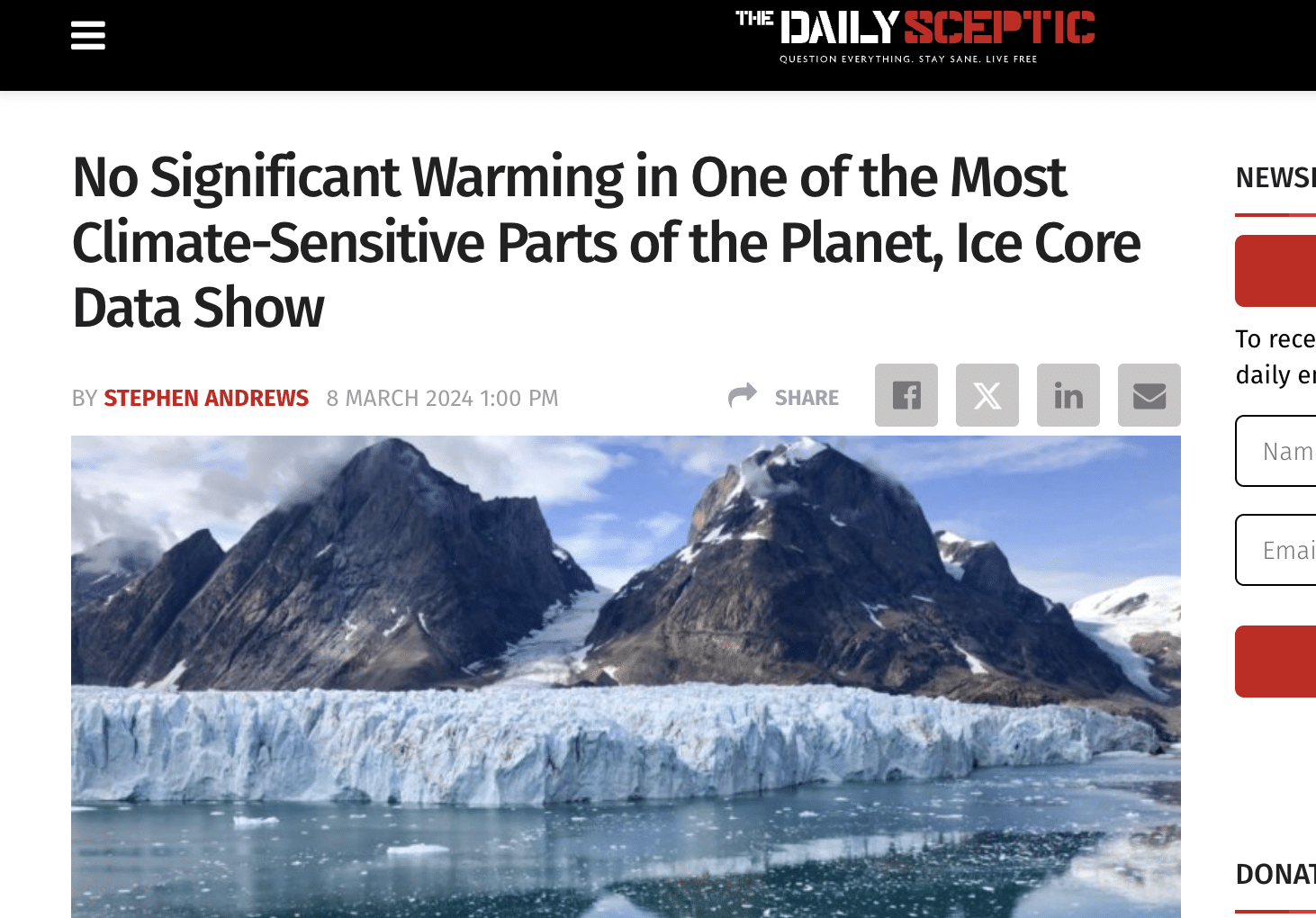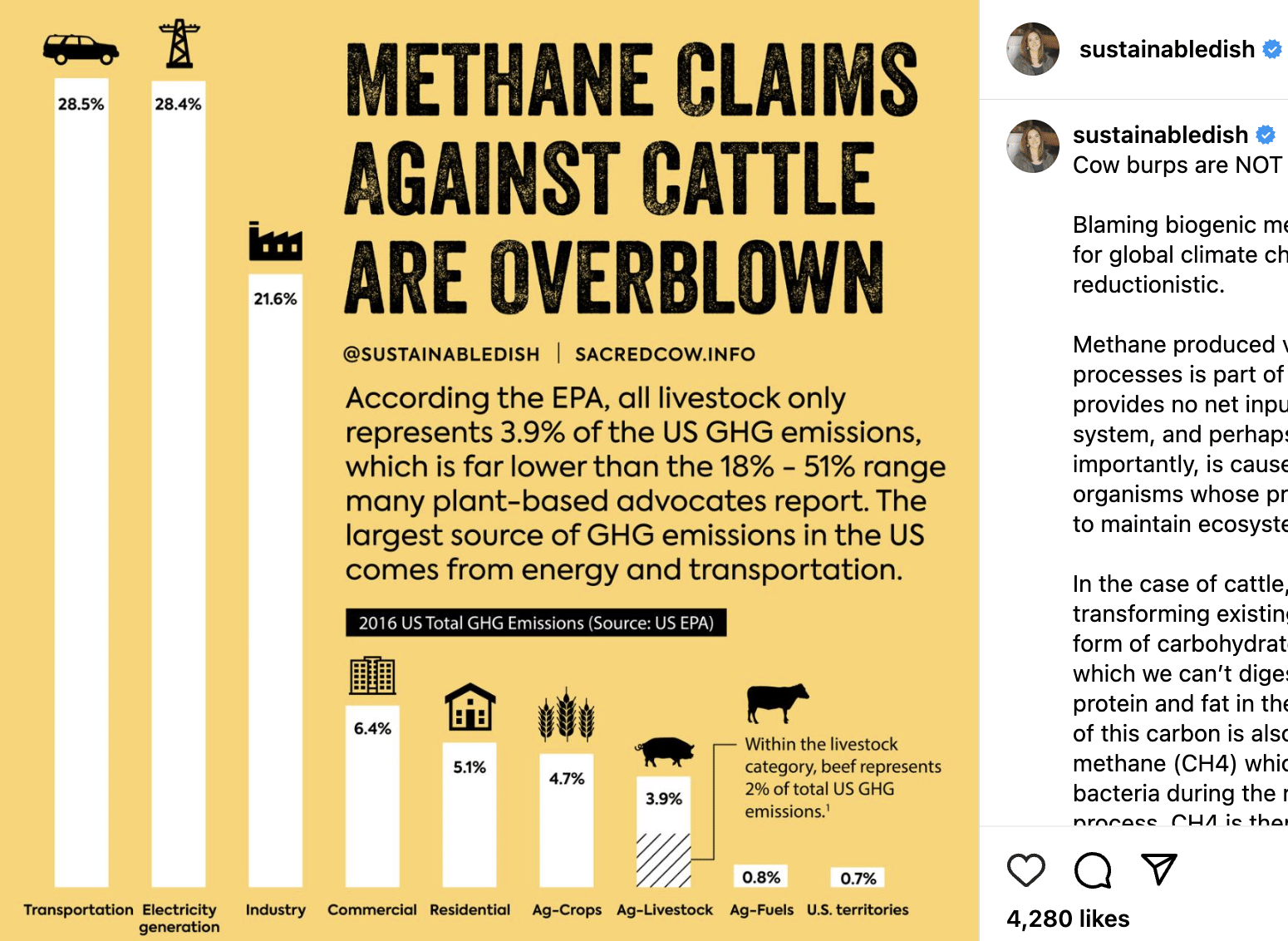- Climate
Evidence greenhouse gasses cause global warming denied by Willie Soon in Tucker Carlson interview, resulting in mass social media climate misinformation
Key takeaway
The causes of climate change and global warming are well-known among the international scientific community. Scientific consensus based on overwhelming evidence, beyond reasonable doubt, shows that anthropogenic greenhouse gas emissions are the main driver of current global warming, not the Sun. Elevated atmospheric carbon dioxide has multiple direct and indirect impacts on the hydrosphere and biosphere, including ocean acidification and arctic sea ice loss due to global warming which affects polar bears.
Reviewed content

Verdict:
Claim:
Carbon dioxide does not cause global warming, scientists are 90% sure it’s the Sun; The climate problems blamed on carbon dioxide (such as ocean acidification and negative impacts on polar bears) are not real
Verdict detail
Incorrect: The hypothesis that the Sun is responsible for climate change is inconsistent with real-world observations. Scientific consensus based on overwhelming evidence shows that greenhouse gasses like carbon dioxide are the main cause of current global warming, beyond reasonable doubt.
Inaccurate: Elevated atmospheric carbon dioxide causes the enhanced greenhouse effect which has multiple direct and indirect impacts on the hydrosphere and biosphere, including ocean acidification and the reduction of arctic sea ice, which affects polar bear populations.
Flawed reasoning: The fact that Saturn’s moon Titan is much colder than Earth despite having more methane does not mean that methane does not cause global warming on Earth as a greenhouse gas. In fact, methane causes the greenhouse effect on Titan just as it does on Earth.
Full Claim
We don’t know what is causing climate change, but we are around 90% sure it’s the Sun. Methane is on Saturn’s moon Titan and it has no global warming; it is cold because it is far from the Sun. There’s also no consensus on the role of CO2. The climate problems of CO2 are artificial and made-up; it does not cause issues like ocean acidification or make any difference to polar bear populations.
Review
Dr. Willie Soon, an astrophysicist and aerospace engineer who has received “much” of his research funding from the oil and gas industry, made multiple claims during an interview with Tucker Carlson denying the role of greenhouse gasses like carbon dioxide (CO2) and methane in driving global warming.
The original video on the Tucker Carlson Youtube page from 9 Jan. 2024 has since been split into numerous snippets, shared, liked, and viewed millions of times across multiple social media platforms. The core of Soon’s claims are inconsistent with science, as we will demonstrate below for three main claims Soon makes within the first third of the interview.
Greenhouse gasses drive recent global warming, not the Sun
Soon: “We may not know exactly what is causing climate change, we suspect it’s the Sun. We have a lot of evidence to show that it’s probably the Sun. Very high percentage, you know like I would say 90% we are sure” (minute 12:47)
The drivers of climate change and global warming are well-known among the international scientific community. There is a straightforward history spanning back to the mid-19th century of how scientists have reached the consensus on anthropogenic climate change, which is that CO2 and other greenhouse gasses like methane emitted by human activities are causing current global warming.
Scientists have known for over a century that CO2, in particular, is a key greenhouse gas that is strengthening the greenhouse effect in the atmosphere. Like the other known infrared-absorbing greenhouse gasses, CO2 absorbs and re-emits heat and therefore maintains a higher temperature in the atmosphere than non-greenhouse gasses. Since the first experiments, like those of Eunice Newton Foote in 1856, countless more studies have tested and validated the warming effect of increased atmospheric-CO2.
Solar irradiance (the amount of power per unit area of solar energy reaching the Earth in the form of electromagnetic radiation, measured in watts per meter squared, W m–2) and its influence on the climate are well-understood by scientists and the evidence shows clearly that solar variability cannot account for the recent warming[1]. The effect of rising rates of atmospheric greenhouse gasses, on the other hand, has been well established by decades of scientific research.
The Sun’s activity has been monitored since the beginning of the 20th century, and although solar irradiance can have yearly fluctuations, there has not been a statistically significant increase in recent decades, as opposed to global temperatures (Fig. 1). Solar irradiance has decreased since the 1960’s while global temperatures have increased. The warming influence of CO2 has been much greater than that of the Sun over the past century.
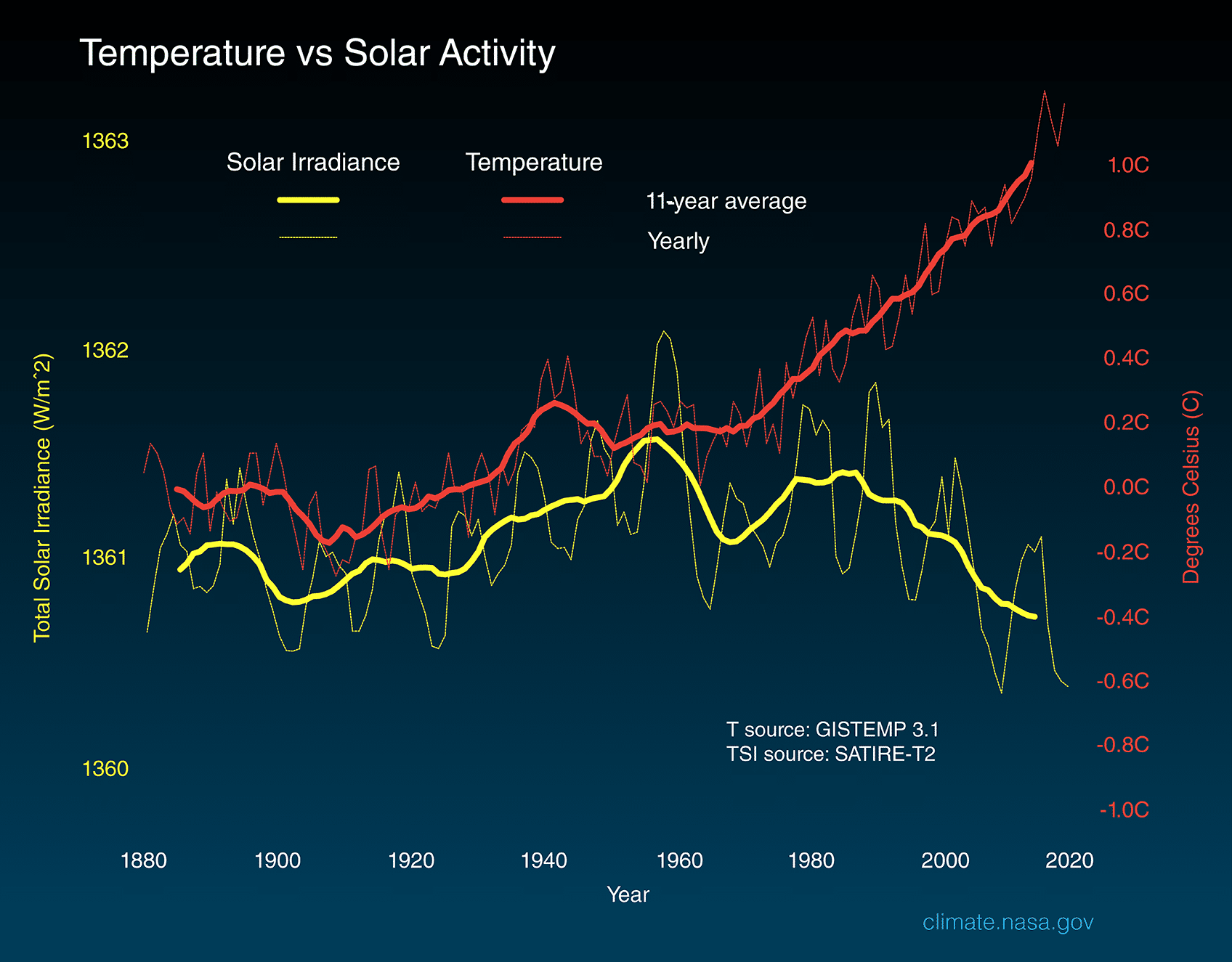
Soon claims the Sun is causing global warming, which means it is causing the recent warming observed at the surface of the Earth (i.e., the troposphere). If this was true, we should be able to observe warming at every layer of the atmosphere, especially at the top which receives the most radiation. Solar radiation reaching the surface on a clear day is around 1000 W m–2, while at the top of the atmosphere it is 1361 W m–2. However, the upper layers of the atmosphere (i.e., the stratosphere) have not increased in temperature in tandem with the surface layer. The temperature in the lower stratosphere (high altitude) has actually fallen while the temperature of the lower troposphere (low altitude) has risen, one of the main “human fingerprints on atmospheric temperature”[2]. This observation is consistent with the enhanced greenhouse effect, where heat-trapping gasses like CO2 in the troposphere cause temperature to increase. This observation is inconsistent with Soon’s claim.
Estimates of the potential contribution of solar radiation to recent global warming further contradict Soon’s claim. At the high end, a 2016 study concluded that “the contribution of changing solar activity either through cosmic rays or otherwise cannot have contributed more than 10% of the global warming seen in the twentieth century”[3]. The IPCC has compiled robust estimates of all of the contributors to observed global warming, concluding that solar activity was a virtually non-existent factor in comparison to anthropogenic greenhouse gasses (Fig. 2). When comparing the effective radiative forcing (ERF, aslo measured in units of watts per meter squared (W m–2)) of global warming contributors since 1750, CO2 has an ERF of 2.16 W m–2, and methane is at 0.54 W m–2. Because these values are positive, they represent energy added to the Earth system, unlike the insignificant ERF for solar (indistinguishable from zero).
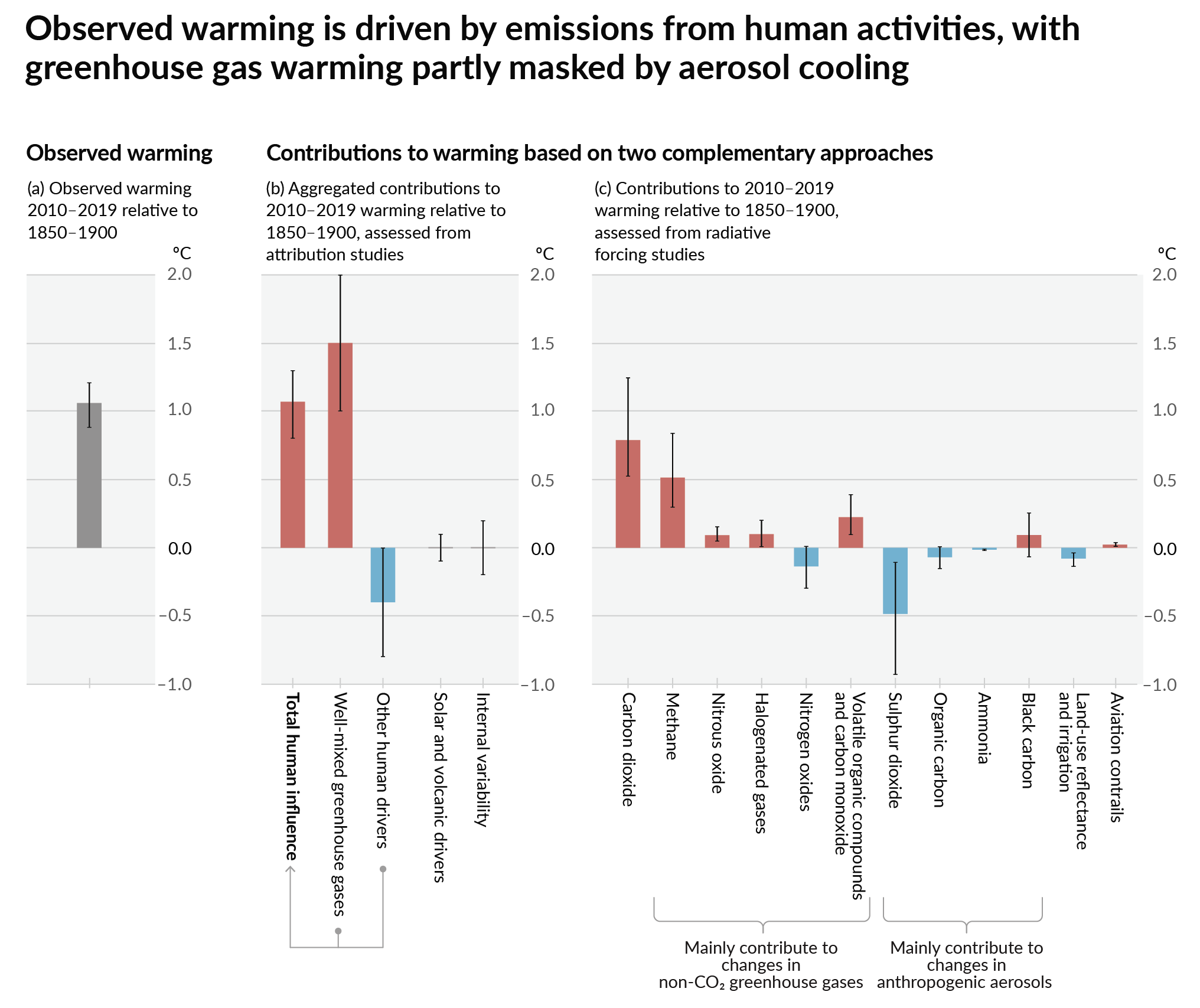
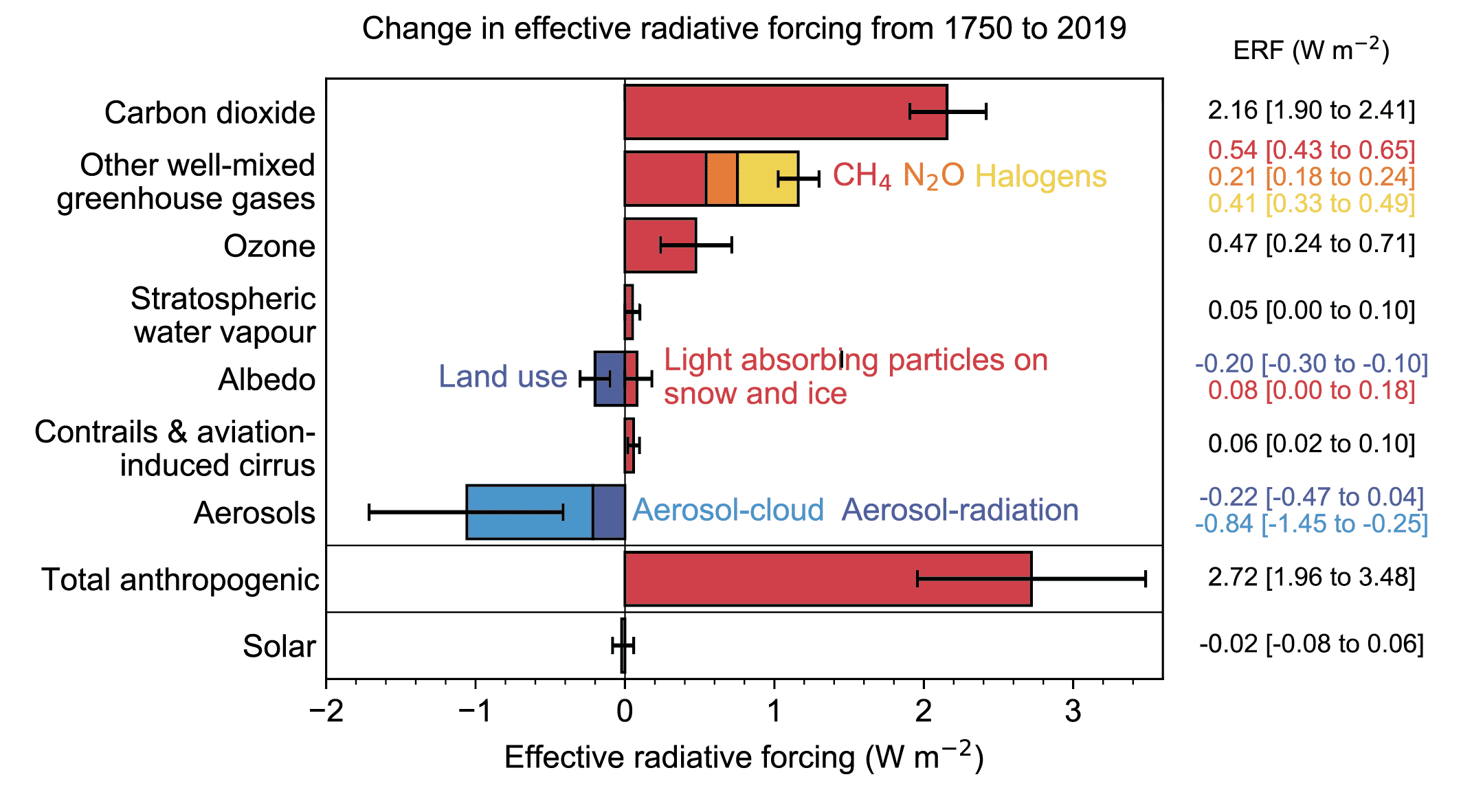
Figure 2 – Top: The contributions of different drivers to global warming from the present time period (2010-2019) relative to the time period of 1850-1900 (source). The estimates of warming (red) and cooling (blue) from radiative forcing studies (panel (c)) are based on both direct emissions into the atmosphere and their effect, if any, on other climate drivers. Bottom: Change in effective radiative forcing from 1750 to 2019 by greenhouse gasses, ozone, stratospheric water vapor, surface albedo, contrails and aviation-induced cirrus, aerosols, and solar. The anthropogenic total category represents the combined positive and negative effects of human activities (everything except solar). The solid bars represent best estimates with very likely (5–95%) ranges represented by the error bars (source).
Multiple direct and indirect environmental impacts of elevated CO2 in the atmosphere
Soon: “What we know now is CO2 ain’t gonna cause nothing. It’s not gonna change much of the climatic system…it won’t make any difference with the polar bear population…it won’t even cause what they call ocean acidification” (minute 8:39)
CO2 is considered the most important greenhouse gas because it has such a long residence time in the atmosphere, it is by far the most abundant, and it contributes the most to global warming and climate change (Fig. 2). Relative to global concentrations in 1750, atmospheric CO2 has increased by 47%[4]. Methane, which breaks down into CO2 after around a decade in the atmosphere, has increased by 156%. Through the enhanced greenhouse effect, human emissions of these gasses have resulted in an increase in average global temperature of more than 1°C since record keeping began in the second half of the 19th century. As temperature is pivotal to Earth’s climate system, Soon’s general claim that CO2 “ain’t gonna cause nothing. It’s not gonna change much of the climatic system” is at odds with reality.
The direct and indirect environmental impacts of high anthropogenic-CO2 emissions are not just related to temperature increases, but also other changes across different components of the Earth system. Aside from air temperature warming, climate change has been observed with the oceans getting warmer, ice sheets shrinking, glaciers retreating, snow cover decreasing, sea level rising, arctic sea ice decreasing, and extreme weather events increasing in frequency (see here for evidence provided by NASA). Soon’s specific claims that CO2 does not make any difference with the polar bear populations nor cause ocean acidification are inaccurate and explored in detail in Box 1.
Box 1. The impacts of CO2 on polar bears and ocean acidification.
Contrary to what Soon claims, CO2 is directly linked to ocean acidification. The ocean has absorbed between 20-30% of total anthropogenic CO2 emissions in recent decades[5]. The excess carbon that is absorbed makes the oceans more acidic because when CO2 dissolves in seawater, it forms carbonic acid, which lowers the pH of the ocean. Global surface ocean waters have increased in acidity by about 30% (because of a pH drop of 0.1) since the beginning of the Industrial Revolution, matching increases in atmospheric-CO2 from human emissions (Fig. 3). Ocean acidification also causes a decline in carbonate ion concentrations and the calcium carbonate saturation state. When this lowers, carbonate minerals will dissolve, which can have implications for organisms with exposed calcium carbonate shells and skeletons, from corals to oysters, clams, and mussels. It has already been shown from experiments that the structure and function of marine species, particularly organisms with calcium carbonate shells or skeletons, are affected by ocean acidification[6].
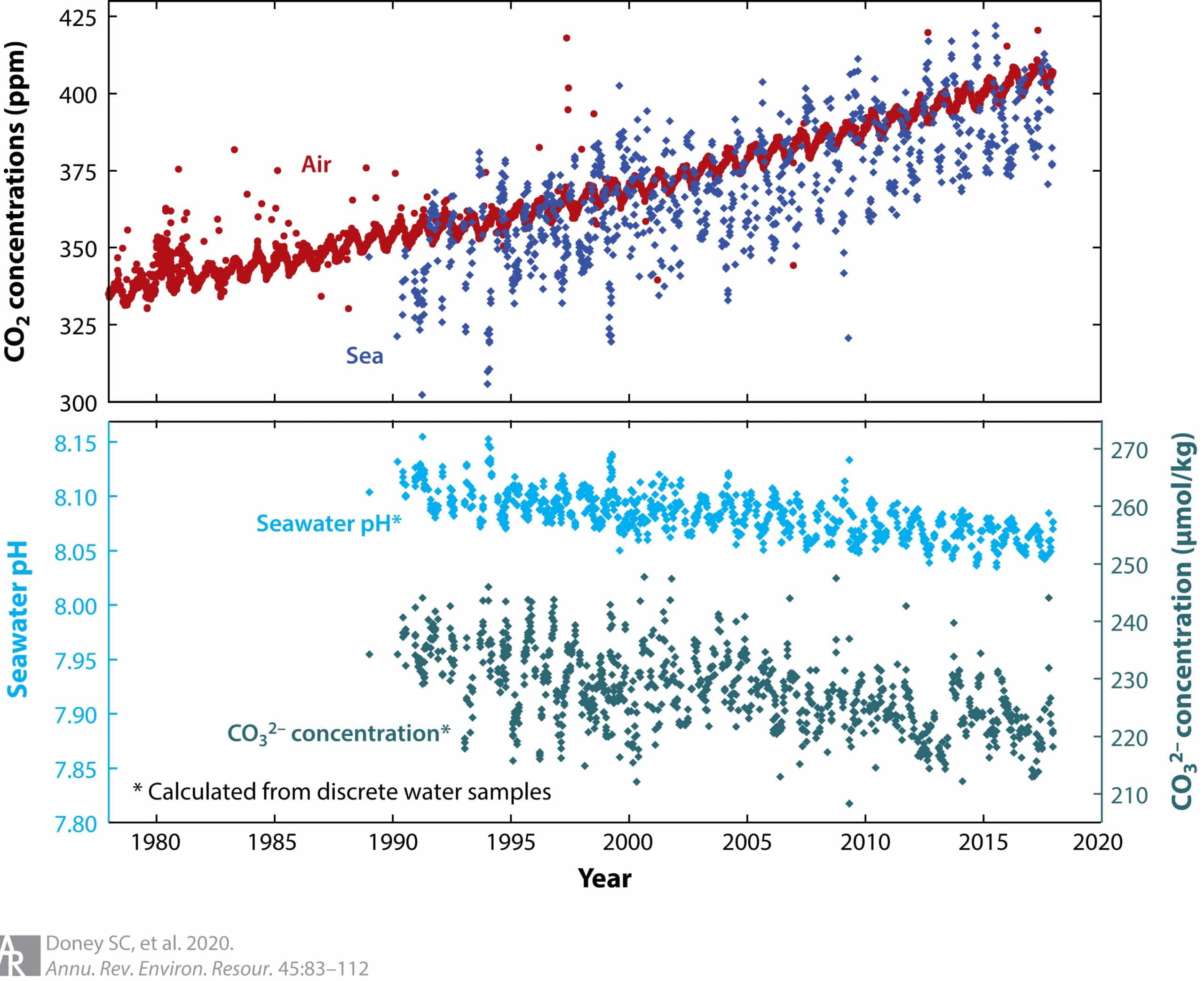
Figure 3 – Recent trends in surface (< 50 m) ocean carbonate chemistry over the period 1988–2015 at the Hawaii Ocean Time-series (HOT) Program in the North Pacific. The upper panel shows the similar increase in CO2 (CO2, as concentration in air (ppm)) in the atmosphere (red points) and surface ocean (blue points). The bottom panel shows a decline in seawater pH (light blue points, primary y-axis) and carbonate ion (CO32−) concentration (green points, secondary y-axis) (source).
By driving global warming and reducing arctic sea ice extent, it is also well established that global warming has and will continue to negatively impact polar bear populations. A 2020 study estimated that, “with high greenhouse gas emissions, steeply declining reproduction and survival will jeopardize the persistence of all but a few high-Arctic subpopulations [of polar bears] by 2100”[7]. Because polar bears depend on sea ice for hunting, and because their main prey seals also depend on sea ice for breeding and making dens, arctic sea ice loss is making it more difficult for polar bears to hunt[8]. Studies correlating local losses in sea ice habitat with polar bear populations found that some subpopulations have already been negatively affected[9-10]. Loss of sea ice is occurring in almost all polar bear subpopulations, with arctic sea ice extent trending downwards since reliable satellite record keeping began in 1979 (Fig. 4). The downward linear trend in Arctic sea ice extent for December over the over four decades of satellite records is 43 400 square kilometers per year, or 3.4 percent per decade relative to the 1981 to 2010 average. Based on the linear trend, December has lost 1.97 million square kilometers of ice since 1979, equivalent to three times the size of Texas. Leading polar bear population experts Dr. Andrew Derocher and Dr. Ian Stirling told Science Feedback in a previous claim review that “Current [polar bear] declines are due to climate change associated loss of sea ice”, and “Several [polar bear] populations…declined significantly as a direct result of climate warming causing steady loss of sea ice”, respectively.

Figure 4 – Monthly December ice extent shows a decline of 3.4 percent per decade over the period from 1979 to present day (source).
Titan is climatically distinct from Earth and yet methane still causes the greenhouse effect on both
Soon: “Titan…it’s very cold by the way, so it’s minus 290 degrees Fahrenheit. Hint, hint, hint, where is the global warming there, right, if it’s full of methane?…because it’s far away from the Sun that’s what it is.” (minute 2:33)
Titan is much colder than Earth because it is far from the Sun, but Soon uses flawed reasoning to claim this means methane does not cause global warming (on Titan or on Earth). Dr. Sarah Hörst, Associate Professor at John Hopkins University and one of the world’s leading experts on Titan’s atmosphere and climate[11], explained to Science Feedback that “Titan receives substantially less Sunlight than the Earth so it should be about 82 Kelvin (-191.15 °C) but the greenhouse effect provided by methane results in a surface temperature that is about 12 K warmer”. Titan orbits Saturn, which is 1.4 billion kilometers away from the Sun on average, compared to Earth’s average distance of 150 million kilometers. Titan’s average temperature is around -179 °C (-290 °F), compared to Earth’s at around +15°C.
So, even though Titan is still very cold (-179°C) because it is so far from the Sun, it would be even colder (-191 °C) without methane causing the greenhouse effect like it does on Earth. Titan receives approximately 1% of the solar radiation that Earth receives. Furthermore, of the solar radiation reaching the top of Titan’s atmosphere, only 10% reaches the surface (compared to 57% for Earth). Titan’s distinct atmosphere to Earth actually features both a greenhouse effect (provided by methane and collision-induced absorption) and an anti-greenhouse effect (from the stratospheric haze layer). For comparison, an Earth without methane and all the other greenhouse gasses causing the greenhouse effect, would be around -33°C colder.
There are other reasons why Soon’s comparison of Earth and Titan to deny methane’s role in the greenhouse effect is flawed. At Earth’s current temperature, the atmosphere is able to hold on average 0.4% water vapor ranging from 4% in the humid tropics to nearly 0% in the polar regions. Water vapor, a known greenhouse gas explored in a previous Science Feedback claim review, is responsible for about half of the natural greenhouse gas effect keeping Earth warm. Titan, on the other hand, has virtually no water vapor anywhere because it is so cold and it has no liquid water. Overall, Titan has a completely different atmospheric composition, pressure, and gravity than Earth.
Both Titan and Earth have a stratified atmosphere with a troposphere, stratosphere, mesosphere, and thermosphere, but Titan’s is much more extended because of its lower surface gravity (reaching heights of 15–50 km compared to Earth’s 5–8 km)[12]. Although Earth and Saturn’s moon Titan are the only two astronomical bodies with significant atmospheres and surface seas with stable liquids in the solar system, Titan’s climate cannot be directly compared to Earth’s.
Titan’s atmosphere is mostly molecular nitrogen (about 95%) and methane (about 5%), compared to Earth’s 78% and 0.00018%, respectively. There is no widely accepted answer for how so much methane appeared on Titan, but there is no mystery that hydrocarbons can exist without originating from organic lifeforms like fossil fuels from plants and animals. Methane exists off Earth as a gas, liquid, or as ice. It is found on Neptune, Uranus, and there’s so much on Titan that it rains methane and there are lakes and rivers of liquid methane (and ethane). It is one of the most abundant types of ice detected outside of our solar system too, and scientists have even managed to create methane in a laboratory under space-like conditions.
Additional context
As we have shown above, Soon made multiple incorrect claims about the science of how greenhouse gasses like CO2 and methane are driving global warming. In the video, Soon also claimed the scientific evidence for global warming driven by CO2 is “all artificial” and dreamed up by the “tyranny of the few”.
First, as we have shown, the science of climate change is actually built on real evidence that has been studied and compiled by tens of thousands of scientists over decades. Second, climate contrarians like Soon are, in fact, the extreme minority who have a disproportionately large influence over public opinion. Nearly all scientists agree greenhouse gas emissions are the cause of global warming. Among scientists with the most climate-related expertise, the consensus reaches 100%[13]. A recent peer-reviewed scientific study analyzing thousands of other peer-reviewed scientific studies found that 99% of the scientific literature confirms human greenhouse gas emissions cause global warming[14].
In the most recent IPCC report (AR6), the very first text line (line A.1.) of the “Summary for Policymakers” directly contradicts Soon by stating “Human activities, principally through emissions of greenhouse gasses, have unequivocally caused global warming”[15]. The report confirms there has been 1.1°C of global warming since the period 1850-1900 and it explicitly identifies CO2 from human emissions as the leading cause (Fig. 2). As an indication of the scientific robustness of AR6, just the contribution from Working Group 1 alone was written by 234 of the world’s leading climate scientists coming from 66 countries. It included nearly 4 000 pages of research based on more than 14 000 scientific papers as supporting references and was critiqued and revised by over 1 500 expert reviewers.
Incorrect and inaccurate claims like those made by Dr. Willie Soon in his interview with Tucker Carlson reach millions of people, amplified across social media platforms; they become super-spreaders of climate misinformation.
REFERENCES
- 1 – Lockwood (2008) Recent changes in solar outputs and the global mean surface temperature. III. Analysis of contributions to global mean air surface temperature rise. In Proceedings of the Royal Society of London A: Mathematical, Physical and Engineering Sciences.
- 2 – Santer et al. (2023) Exceptional stratospheric contribution to human fingerprints on atmospheric temperature. Proceedings of the National Academy of Sciences.
- 3 – Sloan et al. (2016) Cosmic rays, solar activity and the climate. Environmental Research Letters.
- 4 – IPCC (2021) Climate Change 2021: The Physical Science Basis. Contribution of Working Group I to the Sixth Assessment Report of the Intergovernmental Panel on Climate Change.
- 5 – Friedlingstein et al. (2022) Global carbon budget 2022. Earth System Science Data Discussions.
- 6 – Gazeau et al. (2007) Impact of elevated CO2 on shellfish calcification. Geophysical Research Letters.
- 7 – Molnár et al. (2020) Fasting season length sets temporal limits for global polar bear persistence. Nature Climate Change.
- 8 – Stern et al. (2016) Sea-ice indicators of polar bear habitat. The Cryosphere.
- 9 – Bromaghin et al. (2015) Polar bear population dynamics in the southern Beaufort Sea during a period of sea ice decline. Ecological Applications.
- 10 – Lunn et al. (2016) Demography of an apex predator at the edge of its range: impacts of changing sea ice on polar bears in Hudson Bay. Ecological Applications.
- 11 – Hörst (2017). Titan’s atmosphere and climate. Journal of Geophysical Research: Planets.
- 12 – MacKenzie et al. (2021). Titan: Earth-like on the outside, ocean world on the inside. The Planetary Science Journal.
- 13 – Myers et al. (2021) Consensus revisited: quantifying scientific agreement on climate change and climate expertise among Earth scientists 10 years later. Environmental Research Letters
- 14 – Lynas et al. (2021) Greater than 99% consensus on human caused climate change in the peer-reviewed scientific literature. Environmental Research Letters
- 15 – IPCC (2023) Summary for Policymakers. In: Climate Change 2023: Synthesis Report. Contribution of Working Groups I, II and III to the Sixth Assessment Report of the Intergovernmental Panel on Climate Change

